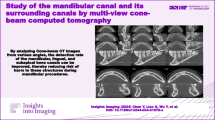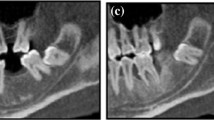Abstract
Purpose
The mandibular canal is a significant anatomical structure in implant dentistry, and cone beam computed tomography (CBCT) is an important diagnostic image modality in this field of dentistry. The aim of this study was to evaluate the frequencies of anatomic variations and lesions affecting the mandibular canal in CBCT images of the mandible produced for dental implant planning.
Methods
This cross-sectional study evaluated a sample of 250 CBCT examinations (500 mandibular canals). The inclusion criterion was CBCT examinations of the mandible requested for dental implant planning. The presence of anatomic variations and lesions affecting the mandibular canal was evaluated in the CBCT examinations. Moreover, the buccolingual position of the mandibular canal was evaluated in the molar region and in the ramus region. The CBCT exams were evaluated by one observer. The data were analyzed using descriptive and analytical statistics. The one-way ANOVA test was employed to compare the age between the anatomic variations. A paired t test was used to compare the buccolingual position between the molar region and the ramus region. Differences were considered significant when p values were lower than 0.05.
Results
The anatomic variations detected were large-diameter mandibular incisive canal (51.6 %), ramification (12 %), and accessory mental foramen (3.2 %). No difference was observed in the age of the patients between the anatomic variations (p > 0.05). The identified lesions included hypomineralization of the canal walls (20.8 %), idiopathic osteosclerosis (8.8 %), osteolytic lesions (3.2 %), iatrogenic perforation of the mandibular canal (2.8 %), and fibro-osseous lesions (1.6 %). The distance between the mandibular canal and the vestibular cortical bone was higher in the molar region than in the ramus region (p < 0.05).
Conclusions
Anatomic variations and lesions affecting the mandibular canal were common findings in the CBCT images of the mandible produced for dental implant planning. An awareness of these alterations is important for dentistry because some of them might require treatment, change oral surgery planning and difficult inferior alveolar nerve anesthetic block.




Similar content being viewed by others
References
Al-Ani O, Nambiar P, Ha KO, Ngeow WC (2013) Safe zone for bone harvesting from the interforaminal region of the mandible. Clin Oral Implants Res 24(Suppl A 100):115–121
Angelopoulos C, Aghaloo T (2011) Imaging technology in implant diagnosis. Dent Clin North Am 55(1):141–158
Aziz SR, Pulse C, Dourmas MA, Roser SM (2002) Inferior alveolar nerve paresthesia associated with a mandibular dentigerous cyst. J Oral Maxillofac Surg 60(4):457–459
Balcioglu HA, Kocaelli H (2009) Accessory mental foramen. N Am J Med Sci 1(6):314–315
Bilecenoglu B, Tuncer N (2006) Clinical and anatomical study of retromolar foramen and canal. J Oral Maxillofac Surg 64(10):1493–1497
Boeddinghaus R, Whyte A (2008) Current concepts in maxillofacial imaging. Eur J Radiol 66(3):396–418
Curien R, Braun M, Perez M, Bravetti P, Coqueugniot H (2011) Discriminant study of the development of the mandibular units in a neural reference system. Surg Radiol Anat 33(3):191–196
Denissen HW, Veldhuis HA, van Faassen F (1984) Implant placement in the atrophic mandible: an anatomic study. J Prosthet Dent 52(2):260–263
de Oliveira Júnior MR, Saud AL, Fonseca DR, De-Ary-Pires B, Pires-Neto MA, de Ary-Pires R (2011) Morphometrical analysis of the human mandibular canal: a CT investigation. Surg Radiol Anat 33(4):345–352
de Souza Tolentino E, Silva PA, Pagin O, Centurion BS, Molin SK, de Tolentino Souza L (2013) Uncommon trajectory variations of the mandibular canal and of the mandibular incisive canal: case report. Surg Radiol Anat 35(9):857–861
Ellies LG (1992) Altered sensation following mandibular implant surgery: a retrospective study. J Prosthet Dent 68(4):664–671
Eversole R, Su L, ElMofty S (2008) Benign fibro-osseous lesions of the craniofacial complex. A review. Head Neck Pathol 2(3):177–202
Gahleitner A, Hofschneider U, Tepper G et al (2001) Lingual vascular canals of the mandible: evaluation with dental CT. Radiology 220(1):186–189
Greenstein G, Cavallaro J, Tarnow D (2008) Practical application of anatomy for the dental implant surgeon. J Periodontol 79(10):1833–1846
Gupta J, Ali SP (2013) Cone beam computed tomography in oral implants. Natl J Maxillofac Surg 4(1):2–6
Jacobs R, Mraiwa N, van Steenberghe D, Gijbels F, Quirynen M (2002) Appearance, location, course, and morphology of the mandibular incisive canal: an assessment on spiral CT scan. Dentomaxillofac Radiol 31(5):322–327
Jacobs R, Mraiwa N, Van Steenberghe D, Sanderink G, Quirynen M (2004) Appearance of the mandibular incisive canal on panoramic radiographs. Surg Radiol Anat 26(4):329–333
Kalender A, Orhan K, Aksoy U (2012) Evaluation of the mental foramen and accessory mental foramen in Turkish patients using cone-beam computed tomography images reconstructed from a volumetric rendering program. Clin Anat 25(5):584–592
Kawai T, Hirakuma H, Murakami S, Fuchihata H (1992) Radiographic investigation of idiopathic osteosclerosis of the jaws in Japanese dental outpatients. Oral Surg Oral Med Oral Pathol Oral Radiol 74(2):237–242
Kim ST, Hu KS, Song WC, Kang MK, Park HD, Kim HJ (2009) Location of the mandibular canal and the topography of its neurovascular structures. J Craniofac Surg 20(3):936–939
Koong B (2010) Cone beam imaging: is this the ultimate imaging modality? Clin Oral Implants Res 21(11):1201–1208
Krasny A, Krasny N, Prescher A (2012) Study of inferior dental canal and its contents using high-resolution magnetic resonance imaging. Surg Radiol Anat 34(8):687–693
Landis JR, Koch GG (1977) The measurement of observer agreement for categorical data. Biometrics 33(1):159–174
López-López J, Estrugo-Devesa A, Jane-Salas E, Ayuso-Montero R, Gómez-Vaquero C (2011) Early diagnosis of osteoporosis by means of orthopantomograms and oral x-rays: a systematic review. Med Oral Patol Oral Cir Bucal 16(7):e905–e913
Mardinger O, Chaushu G, Arensburg B, Taicher S, Kaffe I (2000) Anatomic and radiologic course of the mandibular incisive canal. Surg Radiol Anat 22(3–4):157–161
Misch CM (1997) Comparison of intraoral donor sites for onlay grafting prior to implant placement. Int J Oral Maxillofac Implants 12(6):767–776
Misch CM (2000) Use of the mandibular ramus as a donor site for onlay bone grafiting. J Oral Implantol 26(1):42–49
Misch CM, Misch CE, Resnik RR, Ismail YH (1992) Reconstruction of maxillary alveolar defects with mandibular symphysis grafts for dental implants: a preliminary procedural report. Int J Oral Maxillofac Implants 7(3):360–366
Mohammadi Z (2010) Endodontics-related paresthesia of the mental and inferior alveolar nerves: an updated review. J Can Dent Assoc 76:a117
Mraiwa N, Jacobs R, Moerman P, Lambrichts I, van Steenberghe D, Quirynen M (2003) Presence and course of the incisive canal in the human mandibular interforaminal region: two-dimensional imaging versus anatomical observations. Surg Radiol Anat 25(5–6):416–423
Naitoh M, Hiraiwa Y, Aimiya H, Ariji E (2009) Observation of bifid mandibular canal using cone-beam computerized tomography. Int J Oral Maxillofac Implants 24(1):155–159
Naitoh M, Hiraiwa Y, Aimiya H, Gotoh K, Ariji E (2009) Accessory mental foramen assessment using cone-beam computed tomography. Oral Surg Oral Med Oral Pathol Oral Radiol 107(2):289–294
Neville BW, Damm DD, Allen CM, Bouquot JE (2009) Oral and maxillofacial pathology. Saunders, StLouis
Orhan K, Aksoy S, Bilecenoglu B, Sakul BU, Paksoy CS (2011) Evaluation of bifid mandibular canals with cone-beam computed tomography in a Turkish adult population: a retrospective study. Surg Radiol Anat 33(6):501–507
Oliveira-Santos C, Souza PH, Azambuja Berti-Couto S et al (2012) Assessment of variations of the mandibular canal through cone beam computed tomography. Clin Oral Investig 16(2):387–393
Ozturk A, Potluri A, Vieira AR (2012) Position and course of the mandibular canal in skulls. Oral Surg Oral Med Oral Pathol Oral Radiol 113(4):453–458
Pires CA, Bissada NF, Becker JJ, Kanawati A, Landers MA (2012) Mandibular incisive canal: cone beam computed tomography. Clin Implant Dent Relat Res 14(1):67–73
Politis C, Ramírez XB, Sun Y, Lambrichts I, Heath N, Agbaje JO (2013) Visibility of mandibular canal on panoramic radiograph after bilateral sagittal split osteotomy (BSSO). Surg Radiol Anat 35(3):233–240
Pommer B, Tepper G, Gahleitner A, Zechner W, Watzek G (2008) New safety margins for chin bone harvesting based on the course of the mandibular incisive canal in CT. Clin Oral Implants Res 19(12):1312–1316
Renton T (2010) Prevention of iatrogenic inferior alveolar nerve injuries in relation to dental procedures. Dent Update 37 (6):350–352, 354–356, 358–360
Romanos GE, Greenstein G (2009) The incisive canal. Considerations during implant placement: case report and literature review. Int J Oral Maxillofac Implants 24(4):740–745
Romanos GE, Papadimitriou DE, Royer K et al (2012) The presence of the mandibular incisive canal: a panoramic radiographic examination. Implant Dent 21(3):202–206
Rouas P, Nancy J, Bar D (2007) Identification of double mandibular canals: literature review and three case reports with CT scans and cone beam CT. Dentomaxillofac Radiol 36(1):34–38
Sanchis JM, Penarrocha M, Soler F (2003) Bifid mandibular canal. J Oral Maxillofac Surg 61(4):422–424
Scarfe WC, Li Z, Aboelmaaty W, Scott SA, Farman AG (2012) Maxillofacial cone beam computed tomography: essence, elements and steps to interpretation. Aust Dent J 57(Suppl 1):46–60
Sisman Y, Ertas ET, Ertas H, Sekerci AE (2011) The frequency and distribution of idiopathic osteosclerosis of the jaw. Eur J Dent 5(4):409–414
Sisman Y, Sahman H, Sekerci A, Tokmak TT, Aksu Y, Mavili E (2012) Detection and characterization of the mandibular accessory buccal foramen using CT. Dentomaxillofac Radiol 41(7):558–563
Stella JP, Tharanon W (1990) A precise radiographic method to determine the location of the inferior alveolar canal in the posterior edentulous mandible: implications for dental implants. Part I: Technique. Int J Oral Maxillofac Implants 5(1):15–22
Suomalainen A, Kiljunen T, Käser Y, Peltola J, Kortesniemi M (2009) Dosimetry and image quality of four dental cone beam computed tomography scanners compared with multislice computed tomography scanners. Dentomaxillofac Radiol 38(6):367–378
Takahashi A, Watanabe H, Kamiyama Y, Honda E, Sumi Y, Kurabayashi T (2013) Localizing the mandibular canal on dental CT reformatted images: usefulness of panoramic views. Surg Radiol Anat 35(9):803–809
Tepper G, Hofschneider UB, Gahleitner A, Ulm C (2001) Computed tomographic diagnosis and localization of bone canals in the mandibular interforaminal region for prevention of bleeding complications during implant surgery. Int J Oral Maxillofac Implants 16(1):68–72
Toh H, Kodama J, Yanagisako M, Ohmori T (1992) Anatomical study of the accessory mental foramen and the distribution of its nerve. Okajimas Folia Anat Jpn 69(2–3):85–88
Waldron CA (1993) Fibro-osseous lesions of the jaws. J Oral Maxillofac Surg 51(8):828–835
Watanabe H, Honda E, Tetsumura A, Kurabayashi T (2011) A comparative study for spatial resolution and subjective image characteristics of a multi-slice CT and a cone-beam CT for dental use. Eur J Radiol 77(3):397–402
Yeler H, Ozeç I, Kiliç E (2004) Infection-related inferior alveolar and mental nerve paresthesia: case reports. Quintessence Int 35(4):313–316
Yonetsu K, Yuasa K, Kanda S (1997) Idiopathic osteosclerosis of the jaws: panoramic radiographic and computed tomographic findings. Oral Surg Oral Med Oral Pathol Oral Radiol 83(4):517–521
Acknowledgments
This study was supported by grants from the Conselho Nacional de Desenvolvimento Científico e Tecnológico—CNPq, the Fundação de Amparo à Pesquisa do Estado de Minas Gerais—FAPEMIG, and the Fundo de Incentivo à Pesquisa da PUC Minas—FIP PUC Minas, Brazil.
Conflict of interest
The authors state that there are no conflicts of interest.
Author information
Authors and Affiliations
Corresponding author
Rights and permissions
About this article
Cite this article
Leite, G.M.F., Lana, J.P., de Carvalho Machado, V. et al. Anatomic variations and lesions of the mandibular canal detected by cone beam computed tomography. Surg Radiol Anat 36, 795–804 (2014). https://doi.org/10.1007/s00276-013-1247-5
Received:
Accepted:
Published:
Issue Date:
DOI: https://doi.org/10.1007/s00276-013-1247-5




